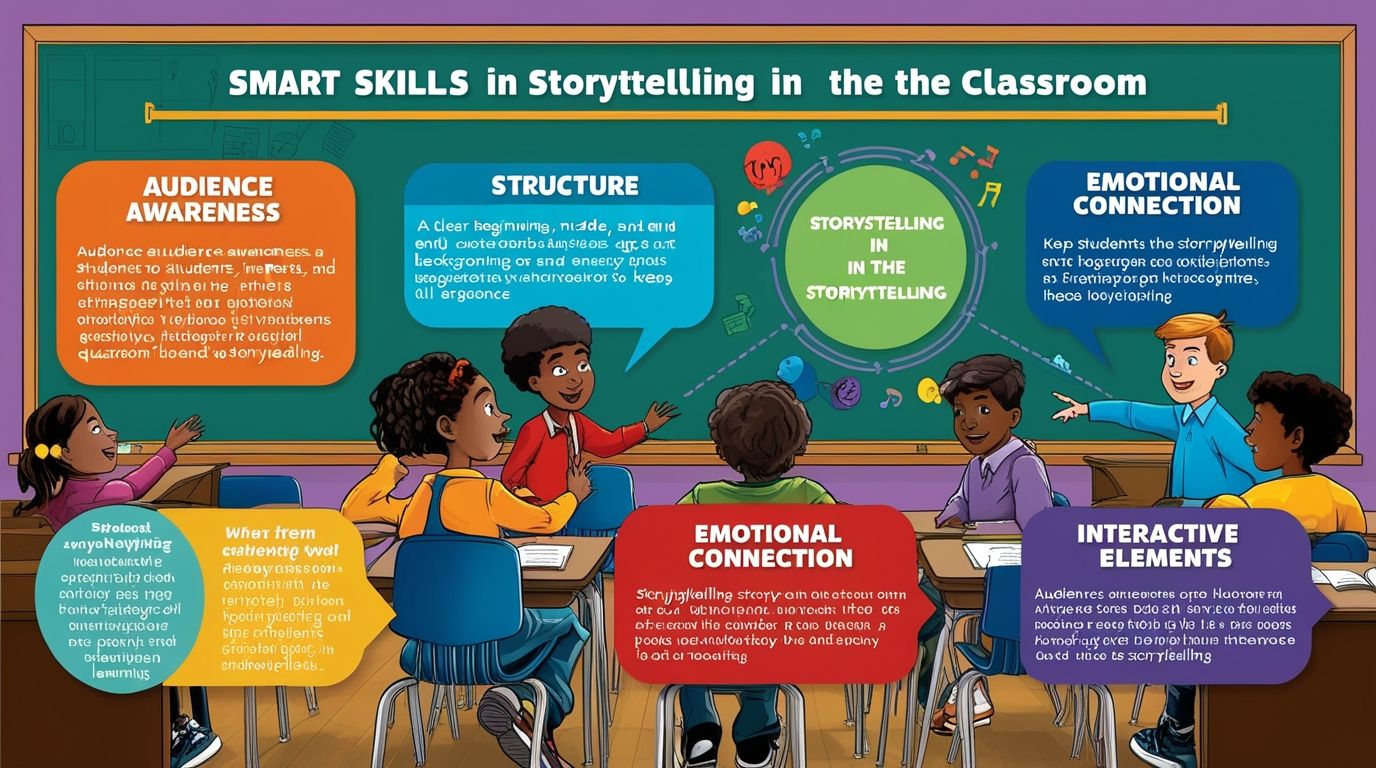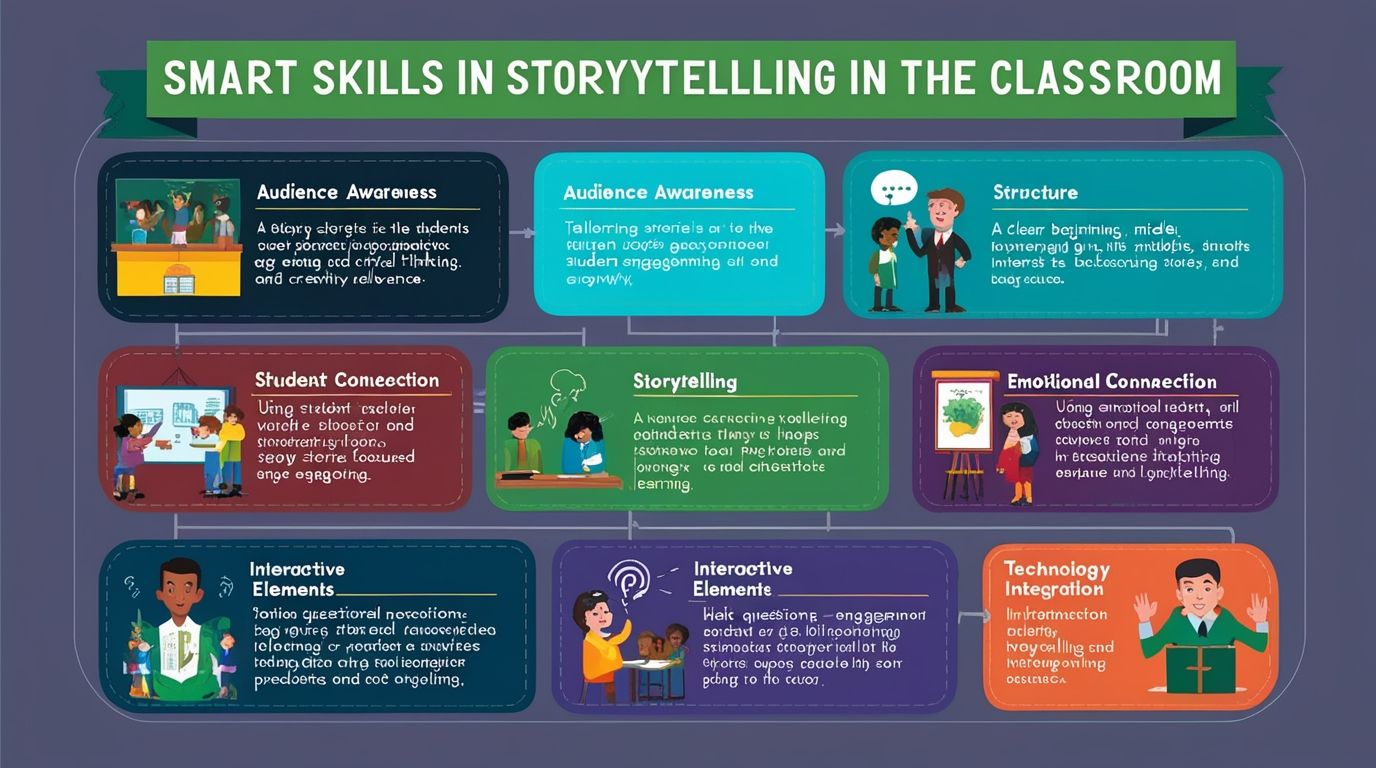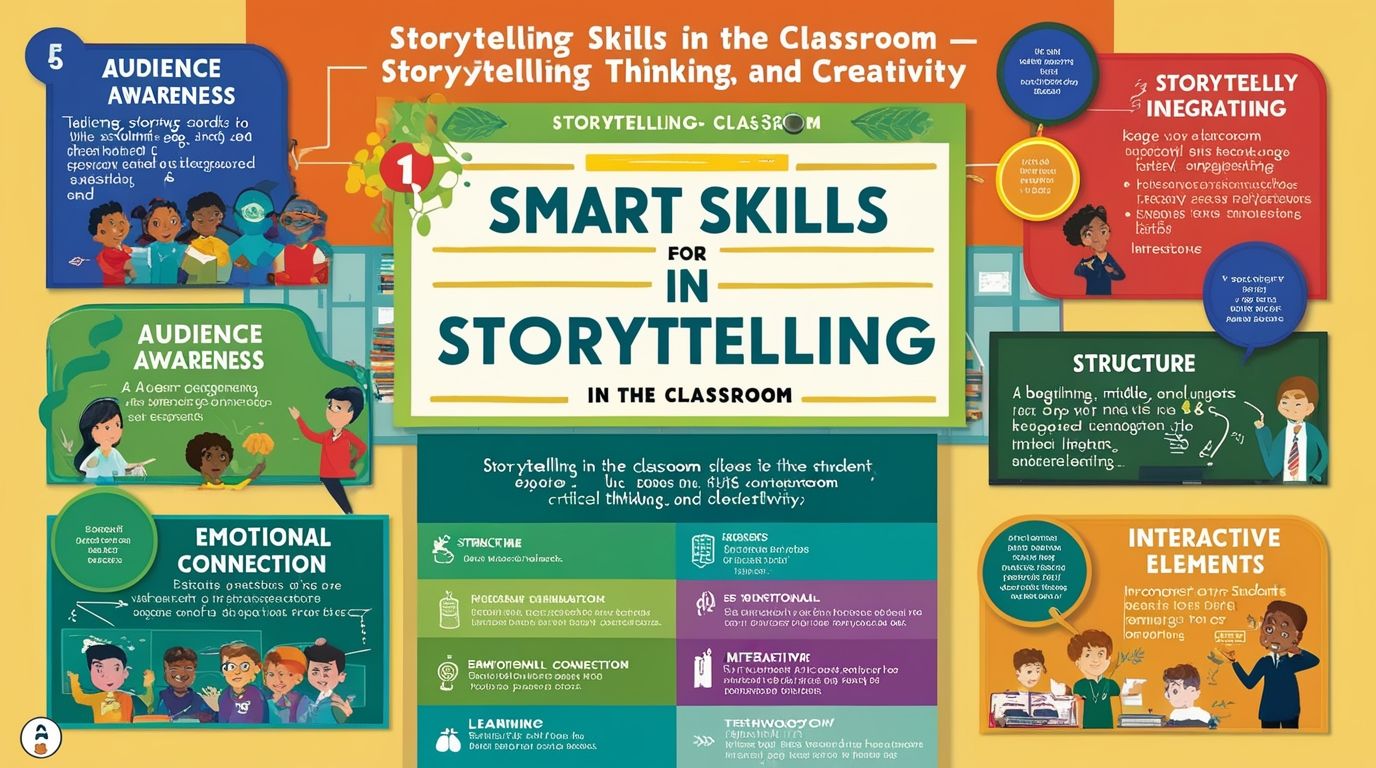Smart Skills in Storytelling in the Classroom, Storytelling is a powerful educational tool that enhances learning by engaging students, fostering imagination, and making complex concepts more relatable. Smart skills in storytelling can transform a classroom into an interactive, dynamic environment where students actively participate and absorb lessons more effectively. This article explores various smart skills that educators can use to enhance storytelling in the classroom, emphasizing techniques that can captivate students’ attention, stimulate their creativity, and improve their learning outcomes.
1. Understanding the Power of Storytelling
Storytelling has been a fundamental part of human culture for centuries, serving as a medium for teaching, entertainment, and preserving traditions. In education, storytelling can:
- Make abstract or complex subjects more accessible by framing them within relatable narratives.
- Encourage empathy by allowing students to see the world from different perspectives.
- Improve retention and recall by linking information to a compelling story.
- Promote critical thinking and creativity by prompting students to analyze, interpret, and even create their own stories.
Using these aspects effectively requires smart skills that educators can develop and refine.
2. Key Smart Skills in Storytelling
A. Audience Awareness
One of the most important skills in storytelling is understanding your audience. In the classroom, this means knowing the age, interests, background, and comprehension levels of your students. This awareness helps in crafting stories that are both engaging and appropriate for the learners. For example:
- Age-appropriate content: Younger students may prefer simpler stories with clear morals, while older students might enjoy more complex narratives with deeper themes.
- Relatability: Stories that connect with students’ experiences or interests are more likely to capture their attention.
Practical Tip: Use surveys, discussions, or observation to gauge students’ interests and backgrounds. Tailor stories to reflect these insights, making them more relatable and impactful.

B. Structuring the Story
A well-structured story is key to maintaining engagement. Effective storytelling typically follows a classic structure: a beginning that sets the stage, a middle that introduces conflict or challenges, and an end that resolves the narrative. This structure can be adapted to suit educational content:
- Beginning: Introduce the topic or concept in a way that sparks curiosity.
- Middle: Present challenges, problems, or conflicts related to the topic that require resolution.
- End: Conclude with a resolution that reinforces the lesson or concept, ensuring students understand the takeaways.
Practical Tip: Use storyboarding techniques to outline the story before presenting it. Visual aids like drawings or diagrams can help organize thoughts and keep the story coherent.
C. Emotional Engagement
Engaging students emotionally is a powerful way to make storytelling effective. Stories that evoke emotions—whether joy, sadness, excitement, or surprise—tend to be more memorable. To achieve this:
- Character Development: Create characters that students can relate to or care about. Well-developed characters drive emotional engagement.
- Sensory Language: Use descriptive language that appeals to the senses, helping students visualize scenes, feel emotions, and connect more deeply with the story.
Practical Tip: Encourage students to express how they feel about the characters and events in the story. This reflection can deepen their understanding and connection to the material.
D. Interactive Storytelling
Interactive storytelling involves engaging students actively during the storytelling process. This can be achieved through:
- Questions and Predictions: Pause during the story to ask students what they think will happen next or how a character might react. This keeps students engaged and encourages critical thinking.
- Role-playing: Have students act out parts of the story. This not only makes the storytelling more dynamic but also helps students better understand different perspectives.
Practical Tip: Use props, costumes, or digital tools to enhance role-playing activities. Interactive elements should be simple yet effective in enhancing the narrative.
E. Use of Technology
Technology can enhance storytelling by making it more interactive and visually appealing. Tools such as digital storyboards, animation software, and virtual reality can bring stories to life in ways that traditional methods cannot. Examples include:
- Digital Storybooks: Use apps or software that allow students to read or listen to stories with multimedia elements like images, sound effects, and animations.
- Augmented Reality (AR): AR can transform the classroom environment, allowing students to immerse themselves in the story’s world.
Practical Tip: Incorporate technology in a balanced way. Ensure that it serves to enhance the story rather than distract from the learning objectives.
3. Practical Applications in the Classroom
To implement smart storytelling skills effectively, educators can consider the following applications:
A. Integrating Storytelling with Curriculum
Storytelling can be integrated across various subjects to make learning more engaging:
- Science: Use stories to explain scientific concepts, such as the life cycle of a butterfly narrated from the butterfly’s perspective.
- History: Bring historical events to life by telling them as stories, focusing on the people involved and their experiences.
- Math: Introduce mathematical concepts through problem-based stories that require students to use math to solve challenges.
Practical Tip: Create a thematic approach where a single story or set of stories can be used across multiple lessons to reinforce learning in a cohesive manner.
B. Encouraging Student Storytelling
Empowering students to tell their own stories fosters creativity, confidence, and a deeper understanding of the material. Techniques include:
- Story Circles: Create small groups where students share personal stories related to the lesson.
- Digital Storytelling Projects: Allow students to use technology to create their own stories, incorporating multimedia elements.
Practical Tip: Provide clear guidelines and examples to help students understand how to structure and present their stories. Encourage peer feedback to promote collaborative learning.

C. Addressing Diverse Learning Needs
Storytelling can be adapted to suit various learning needs and styles:
- Visual Learners: Use illustrations, diagrams, and visual storytelling techniques.
- Auditory Learners: Incorporate music, sound effects, and verbal storytelling.
- Kinesthetic Learners: Use physical activities, role-playing, and hands-on storytelling.
Practical Tip: Be mindful of the different ways students absorb information. Provide options and flexibility in storytelling methods to cater to these diverse needs.
4. Challenges and Solutions
While storytelling is a powerful tool, educators may face challenges such as time constraints, lack of resources, or varying student engagement levels. To address these challenges:
- Time Management: Integrate short stories or story fragments into lessons rather than full-length narratives. This allows for storytelling without taking up too much class time.
- Resource Limitations: Use simple, low-cost resources such as printed story cards or free digital tools.
- Varying Engagement: Regularly solicit feedback from students on the storytelling methods used. Adjust based on their responses to keep them engaged.
Practical Tip: Start small and gradually build up the use of storytelling as a teaching tool. Reflect on what works well and what needs adjustment.
5. Conclusion
Smart storytelling in the classroom goes beyond just telling tales—it’s about connecting with students, making learning meaningful, and fostering an environment of curiosity and creativity. By honing skills in audience awareness, structuring, emotional engagement, interaction, and technology use, educators can transform storytelling into a powerful pedagogical tool. When implemented thoughtfully, storytelling not only enhances student engagement and comprehension but also equips students with critical thinking and communication skills that extend beyond the classroom.
Educators who master the art of storytelling can create a vibrant, memorable learning experience that resonates with students long after they leave the classroom.
References
- Miller, T., & Pennycuff, L. (2008). The Power of Story: Using Storytelling to Improve Literacy Learning. Journal of Cross-Disciplinary Perspectives in Education, 1(1), 36-43.
- Robin, B. R. (2008). Digital Storytelling: A Powerful Technology Tool for the 21st Century Classroom. Theory Into Practice, 47(3), 220-228.
- McDrury, J., & Alterio, M. (2003). Learning through Storytelling in Higher Education: Using Reflection & Experience to Improve Learning. Routledge.
- Haven, K. (2007). Story Proof: The Science Behind the Startling Power of Story. Libraries Unlimited.

7 thoughts on “Smart Skills in Storytelling in the Classroom”
Comments are closed.